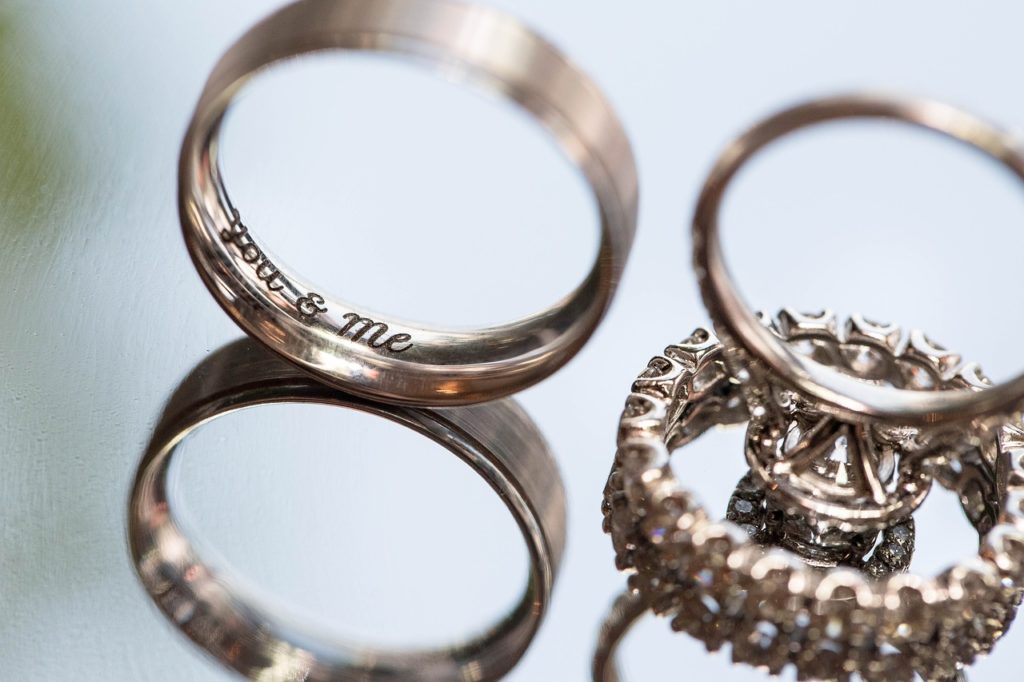All opinions are mine and mine alone.
Picking The Best Engagement Ring Material For You

Choosing the right engagement rings can make all the difference in the world to their recipients. It’s a way for you to show that you pay attention, care, and are thoughtful enough to pick the perfect style for your partner.
Personality
Determining the right engagement ring metals depend on a ton of factors. Only you can decide what the best type is for you depending on your situation. The best way to uncovering the correct ring material is to have a feel for who you’re giving it to. What are their likes? Do they usually wear jewelry? Do they want something unique or classic? Do they want a band or something that you can put diamonds on? Answering the questions before you head out to do your research is essential to making the right decision. This guide helps you with picking the best engagement ring material for you.
The Golds
Gold is maybe the most classic of the engagement ring metals. When you think of rings, you think gold and diamonds. It’s natural–springing to mind whenever you hear the word. Gold is a highly versatile metal and can be used to make intricate patterns and designs. Gold is measured in karats. The purest forms of gold measure in at 24 karats–this means that 24 out of 24 parts contain gold.
Pure gold is actually too soft for jewelry molding, but when combined with other metals, the strength can be increased. When this occurs the measurements will appear as 22K, 18K, 14K, and even 10K. The parts that do not contain gold will most likely contain silver, copper, nickel, or zinc. These metal alloys provide the durability that pure gold needs–they also alter the richness of color. The higher the parts of gold measured, the more saturated the yellow-gold color will appear.
Yellow Gold
Yellow gold is most often a combination of gold, copper, and silver. When blended together, copper brings reddish tones, while the green tint from green softens the hue. The result is classic. The ultimate symbol of wealth and prosperity throughout time. You’ll find yellow gold to be a popular choice among many jewelry pieces.
White Gold
White gold has been increasing in popularity especially among more contemporary jewelry designs. The process begins with yellow gold. The color is lightened with the addition of palladium–a combination of zinc and nickel. White gold is finished with a coating from the platinum metals–rhodium. This heavy duty metal is scratch and tarnish resistant–it is also the reason for the white clean finish. White gold is ideal for those with an affinity for sleek, modern romance.
Rose Gold
Roses turn up the volume on romance and the same is true with rose gold. Rose gold is often referred to as pink gold–as yellow gold gets a boost of help from copper alloy, the result is a warm pinkish hue. This shade of gold is a perfect match for warmer skin tones. The pinkish tones appear almost blushing, and its luxurious warmth brings youthful charm.
Green Gold
A unique choice among the golds, green gold is for those that enjoy something less ordinary. A gold that is inspired by nature, taking on the soft pale green from silver mixed with yellow gold, copper, and zinc. The addition of cadmium can boost even darker green richness. Green gold is enchanting and whimsical.
The Other Metals
Modern brides may be looking at other materials for their engagement rings. A variety of metals found in the scientific world are making their way over to the bridal world. This commingling of industries has led to a rush in popularity for metals like platinum, cobalt, titanium, and tungsten. Harder than gold and more durable means they’ll last longer as well.
Platinum
Many jewelers will tell you that if you want a ring that lasts forever with little risk of damage, go the platinum route. A satin finish gives a classy and luxurious look that will never fade or wear. Platinum is expensive but for good reason. It’s the strongest of the precious metals with the highest levels of purity. Platinum rings typically are made from 95% platinum and 5% of another hard alloy. This gives it an almost indestructible quality. Platinum is the ring that will last forever both in style and in quality.
Palladium
Palladium is lighter than the more expensive platinum but still maintains the quality strength. Scratch resistant and hypoallergenic make it a great ring material for any type of recipient. Palladium has a permanent whiteness that provides a timeless look. A resistance to oxidation, tarnishing, and corrosion makes it a ring that will look sharp and last forever at only a fraction of the cost of the pricier materials.
Sterling Silver
It would be nice if we could all afford solid gold, platinum, or palladium. This isn’t the case with a lot of us. Sterling silver is here to fill the niche. Silver used to be more valuable than gold, while this isn’t true anymore, silver is still quite spectacular. Known as the lunar metal, silver is soft and prone to scratching and warping. Many jewelers have added additional alloys to harden or strengthen the sterling silver bands. Sterling silver gives a timeless look and with proper care will last quite a long time.
Cobalt
Used mainly in aerospace engineering, cobalt rings have been taking the world by storm. Today’s modern brides want non-traditional materials. A way to think outside of the box while, at the same time, thinking about style and grace. This naturally white alloy if four times harder than platinum making it one of the strongest, most durable rings in the marketplace. It’s also one of the hardest metal rings that can also be resized, if needed–a quality that many materials can’t match. If you’re looking for a ring metal that is elegant, solid, and customizable, cobalt is your choice.
Titanium
Once only used for industrial purposes, the momentum for titanium bands are growing. This is mainly due to the possibilities involved with the metal. Titanium is extremely lightweight and is usually paired with another, heavier alloy. This has created some impressive rings that are built on a foundation of titanium but with accents made from the alloy metals. It comes in a variety of colors from white to gray to black making it a unique option. Those that aren’t prone to wearing jewelry will be drawn to titanium once it’s placed on their fingers.
Tungsten
A silver metal that’s four times harder than titanium has led to a rush for tungsten engagement ring bands. Scratch resistant, shatter proof, and a heavy weight makes this a perfect material for those that want to know they have a ring on. The beauty of tungsten is that it’s a pure element–no added alloys to change hardness and durability. It will last a lifetime once it has been forged. A no maintenance ring makes it great for those that want the jewelry without the hassle.
Wood
An odd choice for a list with all metals, wood is becoming a popular choice for brides. Inspired by nature, wood is customizable, affordable, and unique. Inscribing words and patterns into the wood is simple and provides a terrific talking point in any conversation. The choice of wood color, type, and grain are up to you. The options are almost limitless with the right jewelry maker. The costs for wooden rings depend on the style chosen and the artist that’s creating the ring.
Metals have been a valuable source of power and strength for many centuries. We have looked upon metals for spiritual and emotional healing as well as a way to bond with the natural elements of the Earth. Choose a metal that highlights the brilliance of the gemstone or diamond you choose, as well as the style and personality of the woman who will wear it.



Speak Your Mind